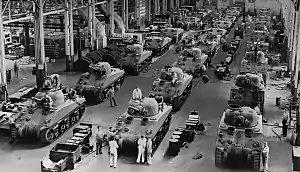Detroit Arsenal (Warren, Michigan)
Detroit Arsenal (DTA), formerly Detroit Arsenal Tank Plant (DATP) was the first manufacturing plant ever built for the mass production of tanks in the United States. Established in 1940 under Chrysler, the plant was owned by the U.S. government until 1996. It was designed by architect Albert Kahn. The building was designed originally as a "dual production facility, so that it could make armaments and be turned into peaceful production at war's end.[1] Notwithstanding its name, the 113-acre (0.46 km2) site was located in Warren, Michigan, Detroit's most populous suburb.[2]
| Detroit Army Arsenal | |
|---|---|
| Part of U.S. Army Tank-automotive and Armaments Command | |
| Warren, Michigan | |
 The plant floor in 1942. | |
| Type | TACOM *Research, Development and Engineering Center *Life Cycle Management Command. |
| Site information | |
| Controlled by | US Army Installation Management Command |
| Garrison information | |
| Garrison | US Army Garrison - Detroit Army Arsenal |
Chrysler's construction effort at the plant in 1941 was one of the fastest on record.[3] The first tanks rumbled out of the plant before its complete construction.[4]
During World War II, the Detroit Arsenal Tank Plant built a quarter of the 89,568 tanks produced in the U.S. overall. The Korean War boosted production for the first time since World War II had ended; the government would suspend tank production after each war. In May 1952, Chrysler resumed control from the army, which had been unable to ramp up production.[1]
As a Government-Owned, Contractor Operated (GOCO) facility, Chrysler retained operational control of the production facility until March 1982, when Chrysler sold its Chrysler Defense division to General Dynamics Land Systems. General Dynamics produced the M1 Abrams tank at the facility (and at another plant in Lima, Ohio) until 1996, when the plant was closed and tank assembly and maintenance operations were consolidated[5] at the Lima plant.[6] The plant and some of the adjoining property were transferred to the City of Warren[7] in 2001. The site of the original tank plant has been parcelled up and is now dedicated to civilian uses.[8]
This important production site of the Arsenal of Democracy is memorialized by a Michigan Historical Marker.[9]
The structure of the plant was designed to survive bombardment by the weapons of the day. It included 3-foot-thick (0.91 m) concrete walls in some areas and a reinforced roof with slats to direct bombs away from vulnerable windows and exhaust fans.
The portion of the property not sold to the city remains an active Army facility with many agencies present. The installation is managed by Installation Management Command (IMCOM) and hosts the headquarters of the United States Army CCDC Ground Vehicle Systems Center (GVSC), formerly United States Army Tank Automotive Research, Development and Engineering Center (TARDEC),[10] and it hosts the United States Army TACOM Life Cycle Management Command. TACOM continues to function at the location, and experienced a major building boom in the 2010s.[11]
Tenant units
- United States Army Tank Automotive Research, Development and Engineering Center (TARDEC)
- United States Army TACOM Life Cycle Management Command TACOM LCMC
Tanks produced
- M3 Lee, 1941-1942
- M4 Sherman, 1941-1945
- M26 Pershing, 1945
- M46 Patton, 1949
- M47 Patton, 1951-1953
- M67 "Zippo", 1955-1956
- M60 Patton, 1960-1987
- M1 Abrams, 1980-1996
Further reading
- Stout, Wesley W. (1946). "Tanks are Mighty Fine Things". Chrysler Corporation. Retrieved 11 July 2019.
- Dasch, Jean M.; Gorsich, D.J. (2012). The TARDEC Story. Sixty-five Years of Innovation 1946-2010. US Army Tank Automotive Research, Development and Engineering Center..
- Detroit Arsenal Tank Plant, Local Legacies. Library of Congress
- Bos, Ann M. and Talbot, Randy, Enough and On Time, The Story of the Detroit Arsenal Tank Plant, Michigan History Magazine. June, 2001.
- Meredith, Robyn, Vast Plant for Tanks Has Closed. 21 December 1996. The New York Times.
Notes
- "Upheaval at the Arsenal". Time. 26 May 1952. Retrieved 21 May 2011.
- "Pure Michigan, Arsenal of Democracy". Ref.michigan.org. 28 July 2010. Archived from the original on 1 June 2009. Retrieved 21 May 2011.
- Dennis Adler (2000). Chrysler. MotorBooks International. p. 68. ISBN 978-1-61060-871-8.
- Ogbac, Stefan (29 December 2015). "Chyrsler Revisits Its Involvement in World War II: Tanks, turrets, airplanes, and Power Wagons" (Photos, Video). Motor Trend. Retrieved 29 December 2015.
- "Closing of Detroit Arsenal Tank Plant" (Press release). 12 August 1996. Archived from the original on 5 May 2006.
- "Land Use Distribution". Ludb.clui.org. Archived from the original on 6 June 2011. Retrieved 21 May 2011.
- "U.S. Army TACOM Life Cycle Management Command History". Tacom.army.mil. Archived from the original on 22 July 2011. Retrieved 21 May 2011.
- "City of Warren Community, Economic and Downtown Development". Cityofwarren.org. 23 August 2005. Archived from the original on 20 May 2011. Retrieved 21 May 2011.
- "Michigan Historical Marker". Michmarkers.com. Archived from the original on 15 March 2010. Retrieved 21 May 2011.
- Dasch, Jean M.; Gorsich, D.J. (2012). The TARDEC Story. Sixty-five Years of Innovation 1946-2010. US Army Tank Automotive Research, Development and Engineering Center.
- "TACOM public website". Tacom.army.mil. Retrieved 21 May 2011.
External links
- Detroit Arsenal of Democracy Museum, Veterans' Memorial Park, 27400 Campbell Road, Warren, Michigan 48093
- "Tanks Are Mighty Fine Things," a booklet about the WW2 History of the Detroit Tank Arsenal.
- Congressional Record , remarks on the dedication of the Michigan Historical Marker concerning the Detroit Arsenal Tank Plant by U.S. Senator Carl Levin.
- Description of Detroit Arsenal Tank Plant at Globalsecurity.org.
- Detroit Tank Arsenal in Warren Township, 1941.
- U.S. Army Tank Automotive Command history.
- Wikimapia, Detroit Arsenal Tank Plant.
- "Tanks are mighty fine things" (1946) at the Internet Archive
- A film clip "Assembly Lines of Defense" is available at the Internet Archive
